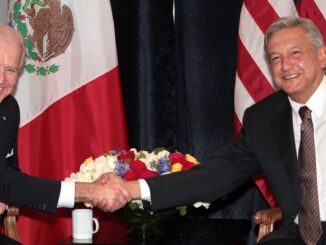By Alexis Arthur
The United States is edging towards an historic agreement to swap crude oil with Mexico. The deal is important as it brings some relief to US producers struggling with a light oil glut at home and for Mexican national oil company, Pemex, which is hoping to mix the lighter crude coming out of US shale fields with its heavier blend.
However, the arrangement is not just about the relationship between the US and Mexico. It’s also about broader North American energy integration. And critically, many experts see the deal as another crack in the US crude oil export ban.
The swap between the US and Mexico – if approved – will allow the US to export 100,000 barrels of oil per day to Mexico. It will not affect US imports of Mexican crude. In February this year, the United States imported 784,000 barrels of crude and petroleum products per day from Mexico.
Twenty-one US senators, led by Sen. Lisa Murkowski, R-Alaska and Sen. Heidi Heitkamp, D-North Dakota, wrote a letter to the Commerce Department recommending the ruling go beyond swaps to allow for exports under the same conditions as Canada. The proposal, they stated, would “harmonize North America’s energy trade.” This is a goal that the current administration appears to agree with.
The deal is historic for several reasons, not least of which the fact that so few exceptions have been made since the crude oil export ban went into place in the 1970s. According to the Department of Commerce’s Export Administration Regulations (Part 754.2(b)(1)) exceptions include exports from Alaska’s Cook Inlet and exports to Canada “for consumption or use therein”. Canada has benefited greatly from the swaps. Alaska exported its first crude in a decade last September, to South Korea.
The oil swap with Mexico not only makes economic sense but also political sense as the North American region becomes increasingly integrated. The North American Free Trade Agreement (NAFTA) celebrated its 20th anniversary last year with some fanfare but there is still more to be done to bring the US, Canada, and Mexico closer together. The White House’s Quadrennial Energy Review, released on April 21, recommends greater integration of North American energy markets. The free trade in crude oil between the three nations would be a positive step.
 Finally, the swap represents a small step towards loosening the crude export ban. The ban, implemented in response to the Arab oil embargo in the 1970s, is widely considered an anachronism by energy experts. Lifting it would likely bring economic benefits to the US. shale producers dealing with a glut of light shale oil that can’t be easily refined on the Gulf Coast but could be sold abroad.
Finally, the swap represents a small step towards loosening the crude export ban. The ban, implemented in response to the Arab oil embargo in the 1970s, is widely considered an anachronism by energy experts. Lifting it would likely bring economic benefits to the US. shale producers dealing with a glut of light shale oil that can’t be easily refined on the Gulf Coast but could be sold abroad.
A report by IHS Cera estimated that lifting the ban could generate from 400,000 to over 800,000 jobs. Another report, by NERA Consulting for the Brookings Institution [PDF], projected that along with rising employment, free trade in oil would also lead to wage increases and lower prices of gasoline for American consumers. All of which are good for US economic recovery and growth.
In addition to the oil swaps with Mexico, another interesting loophole emerged late last year. In November 2014, BHP Billiton became the first company to ship lightly processed condensates without express permission from the Commerce Department. At the time, it looked like real progress towards lifting the restrictions.
Lobbying and politicking has continued apace since then but progress has been slow. US Energy Secretary Ernest Moniz’ support for a review of the ban has kept advocates’ hopes alive.
As for the US crude heading south of the border, the Mexican government is hopeful that the request will soon be approved. It represents a positive but small advance towards the goal of greater energy integration in North America. Whether it will later be seen as a factor in lifting the US crude oil export ban remains to be seen. In the meantime, the immediate benefits for the US and the region should be recognized.



